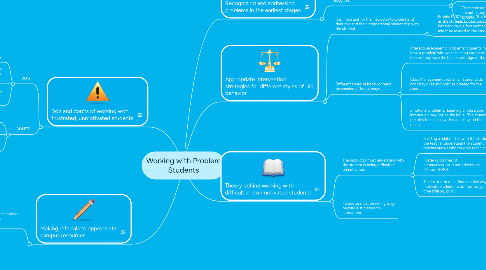
1. Do’s and don’ts of working with frustrated, unmotivated students
1.1. DO'S
1.1.1. Do take the students frustration seriously.
1.1.2. Do communicate with the student. They may not be need special attention or someone to communicate with.
1.1.3. Follow up with the student. Make sure they are aware of all of their options and resources.
1.2. DON'TS
1.2.1. Don't ignore the issue. It can escalate into a bigger problem.
1.2.2. Don't be insensitive to the students' views.
1.2.3. Don't draw your own conclusion to the student's problem.
2. Making referrals to appropriate campus resources
2.1. Whatever the problem being faced, the student should be referred to the appropriate resources.
2.1.1. Student may be dealing with their own mental, physical, or personal issues. Refer the student to a counselor on or off campus.
2.1.2. Student may need tutoring. Refer the student to tutors.
2.1.3. Student may be dealing with issues at home. Refer the student to social service departments.
3. Recognizing and addressing problems in the earliest stages
3.1. These problem students may display different combinations of personal attributes and behavior problems (Brophy, 2003). They will exhibit different characteristics that a teacher should recognize.
3.1.1. Characteristic one: Difficult - The students will not follow the classroom routine (Brophy, 2003).
3.1.2. Characteristic two: Time consuming - The students have issues that require weeks or months of specialized attention (Brophy, 2003).
3.1.3. Characteristic three: Frustrating - The students are not happy with their progress (Brophy, 2003).
4. Appropriate intervention strategies for different styles of behavior
4.1. It is important for the instructor to understand their role and their interpersonal relationship with the student.
4.1.1. Brophy (2003) states, "It is human nature to perceive the problem as the student; but before focusing on changing the student’s behavior, take a few moments to look at what you are doing that might be related to the student’s behavior."
4.2. Different styles of behavior must be handled different ways.
4.2.1. Intellectual/Academic problems: Students may have a problem with what is being taught or believe they have the best knowledge of the topic.
4.2.1.1. Intervention Strategy: Svinivki and McKeachie (2011) state, "When students challenge you, you can demonstrate scholarly debate, including careful listening, thoughtful re" ection, respectful disagreement, and reasonable compromise where appropriate.
4.2.2. Class Management problems: Students do not obey rules and policies created for the class.
4.2.2.1. Intervention Strategy: Since it is possible that some students are not attentive in class, some suggested strategies are having discussions with the students who may be inattentive or creating discussion papers and calling on those students (Svinivki and McKeachie, 2011). This is a strategy to engage the problem students into the classroom discussion.
4.2.3. Emotional problems: Learning or classroom interaction may not be the issue. The student could possibly be dealing with issues beyond the Instructors realm.
4.2.3.1. Students may be angry, sensitive to certain topics, discouraged, dealing with psychological problems, or suicidal.
4.2.3.1.1. Intervention Strategy: Address each issue as a separate situation. Every student is different. If a student is angry about a grade, the teacher should make sure to attentively listen to his or her points. If student is discouraged, the teacher should have a discussion with the student regarding the class and their issues. If is a situation beyond a teachers capacity, refer the student to the proper resources.
5. Theory behind working with difficult and unmotivated students
5.1. The Instructor must understand why the student is being difficult or unmotivated.
5.1.1. Building a relationship with the student will help the teacher understand the student. Once the teacher knows who they are teaching
5.1.2. Foster good lines of communication in both directions (Nilson, 2010).
5.1.3. The Instructor must find creative ways to motivate students to do their assignments on time (Nilson, 2010).
